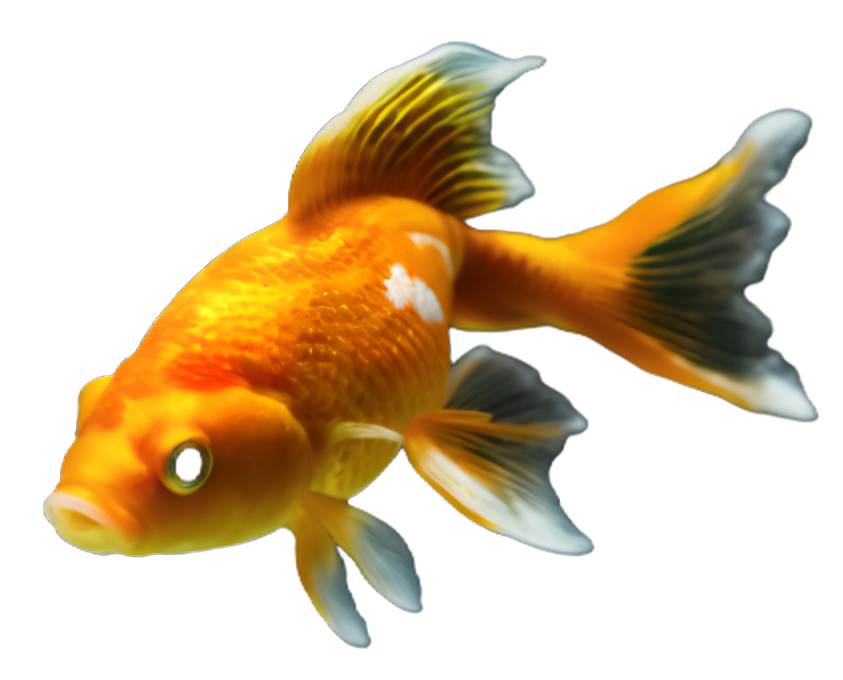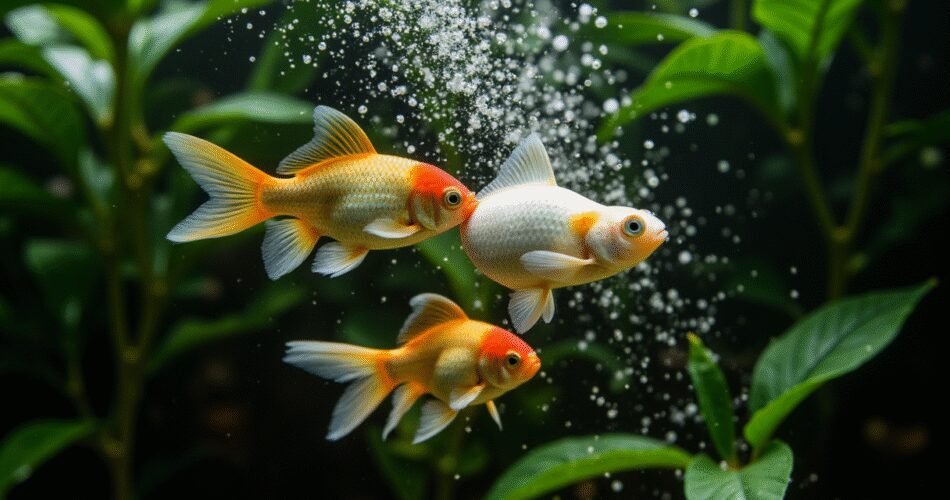Introduction to Goldfish Spawning Behavior and Egg Care 🐟
When my goldfish start spawning, I know it’s time to pay close attention. This fascinating process begins with the males chasing the females, nudging them to release eggs. It’s a sign that breeding is happening, but the real work starts after the eggs are laid. That’s where goldfish egg care becomes crucial.
If I don’t handle the eggs properly, they can easily fall victim to fungus or get eaten by the adults. I’ve learned that separating the eggs into a safe, aerated environment is essential. It’s not just about watching the process—it’s about giving those eggs the best chance to hatch into healthy fry. Trust me, taking care of goldfish eggs is where successful breeding truly begins.
Overview of Goldfish Reproductive Biology 🔬
I’ve always been fascinated by the reproductive biology of goldfish. Let me walk you through how it all works—starting with their anatomy. Female goldfish tend to be rounder, especially when they’re full of eggs, while males develop small white breeding tubercles on their gill covers and pectoral fins when they’re ready to spawn. These physical differences are your first clues to identifying their readiness for reproduction.
When it comes to the spawning cycle, goldfish are egg-layers and typically breed in spring or early summer when water temperatures rise. I watch for signs like chasing behavior—males will nudge and follow the female persistently. This is when spawning happens: the female releases hundreds of eggs, and the male fertilizes them externally. The eggs stick to plants or decorations, and if you’re breeding them intentionally, you’ll need to provide a safe surface or even move the eggs to protect them from being eaten.
Understanding goldfish spawning behavior is key if you want to raise fry successfully. Once the eggs are laid, they usually hatch within a week, depending on temperature. From there, caring for the tiny fry involves providing the right food and clean water—it’s a hands-on process, but incredibly rewarding when you see them grow.
Signs and Indicators of Goldfish Spawning Readiness 👀
When I’m getting ready to spawn, you’ll notice a few clear signs. First, look for tiny white bumps, called breeding tubercles, on my gill covers and the leading edges of my pectoral fins. Males develop these, and they’re a sure sign I’m in spawning condition.
You might also see me chasing other goldfish around the tank—this is part of goldfish spawning behavior. I’ll be nudging and bumping the females, trying to encourage them to release eggs. If I’m a female, my belly will look fuller and rounder as it fills with eggs.
I might also start spending more time near spawning mops or plants, scouting for a good spot to lay or fertilize eggs. And don’t be surprised if I get more colorful or active than usual. All these signs mean I’m ready—so keep an eye out and be prepared for some goldfish egg care soon!
Environmental Conditions That Trigger Spawning 🌡️
I’ve learned that getting goldfish to spawn depends heavily on three key environmental factors: temperature, light, and water quality. Let me break down what works based on my experience.
First, temperature is huge. Goldfish spawning is triggered when water temperatures rise to around 68–74°F (20–23°C). I mimic spring conditions by gradually increasing the tank temperature, which signals to the fish that it’s time to breed. Sudden changes can stress them, so I take it slow.
Next, lighting plays a big role. I extend the daylight hours to about 12–14 hours a day using aquarium lights. This longer photoperiod tricks the goldfish into thinking it’s breeding season, encouraging spawning behavior.
Water quality can’t be overlooked. I keep the water clean with zero ammonia or nitrites and low nitrates. Regular partial water changes with slightly cooler water often stimulate spawning, as it simulates fresh rain—a natural trigger.
When all these elements align, I see more active chasing and egg-laying. After spawning, I focus on goldfish egg care by separating eggs from adults to boost survival rates. It’s all about creating the right environment—consistently.
Goldfish Spawning Behavior: Courtship and Egg Laying 💕
I’ve watched goldfish spawning behavior up close, and it always starts with intense chasing. The males relentlessly pursue the female, nudging her sides and belly to encourage her to release eggs. This is the courtship phase—it can look aggressive, but it’s a natural part of the goldfish egg laying process.
Once the female is ready, she scatters her eggs over plants or spawning mops. The males fertilize them immediately. After spawning, I make sure to separate the adults from the eggs to prevent them from eating their own offspring.
Types of Goldfish Eggs and Their Characteristics 🥚
When I’m checking on goldfish eggs, the first thing I notice is their appearance. Goldfish eggs are tiny, usually about the size of a pinhead, and they have a translucent, gel-like coating. Right after spawning, they look almost clear, but within hours, I can start to see differences between fertilized and unfertilized eggs.
Fertilized eggs develop a small, visible dot in the center—that’s the embryo starting to form. Over the next few days, I watch them turn more opaque, and if I look closely, I can even see tiny eyes and body shapes. Unfertilized eggs, on the other hand, stay completely clear or turn white and cloudy. They don’t change much, and after a day or two, they often get a fuzzy coating, which means they’re rotting.
I always remove those unfertilized ones quickly to keep the water clean for the healthy eggs. It’s amazing how something so small holds so much potential—or signals it’s time to tidy up.
Proper Egg Care: Protecting and Incubating Goldfish Eggs 🛡️
I start by removing the adult goldfish from the tank as soon as I notice the eggs. If I don’t, they’ll eat them. I use a soft siphon or a turkey baster to gently lift the eggs and transfer them to a separate, clean tank with similar water conditions.
To prevent fungus, I add a few drops of methyl blue or a similar antifungal treatment to the water. I keep the water temperature stable—around 70°F (21°C) is ideal—and make sure there’s gentle aeration from an air stone. I don’t use a strong filter, as it could harm the delicate eggs.
I check the eggs daily, removing any that turn white or fuzzy—those are infertile or infected. In about 4–7 days, the eggs hatch. Once they do, I start feeding the fry infusoria or specially formulated fry food until they’re big enough for brine shrimp.
Common Problems During Spawning and Egg Development ⚠️
I’ve been through plenty of goldfish spawning cycles, and I know firsthand how tricky it can be to keep eggs healthy. Here are the most common issues I’ve run into—and what I do to solve them.
Eggs Being Eaten: It’s frustrating when adult goldfish eat their own eggs right after spawning. I always remove the parents from the breeding tank as soon as I notice eggs to prevent this. If you’re not quick, you’ll lose the whole batch.
Fungus on Eggs: White, fuzzy fungus can quickly ruin fertilized eggs. I keep a close eye and remove any infected eggs immediately with tweezers. Adding a gentle antifungal treatment, like methylene blue, to the water helps protect the healthy ones.
Low Fertilization Rates: Sometimes only a small number of eggs get fertilized. I make sure my goldfish are well-conditioned with high-quality food before spawning. Healthy, active breeders lead to better fertilization success.
Poor Hatching Rates: Even fertilized eggs might not hatch if water conditions aren’t right. I keep the water clean and well-oxygenated, with stable temperatures. Any sudden changes can stop development in its tracks.
Staying observant and acting quickly has made all the difference for me in raising goldfish from eggs.
Caring for Newly Hatched Fry: First Steps After Hatching 🐠
The first few days after your goldfish fry hatch are the most critical. I keep them in the same tank where they hatched, making sure the water is clean and the environment is calm. I use a sponge filter to avoid strong currents that could harm the tiny fry.
For feeding, I start with infusoria or liquid fry food right away—they need to eat as soon as they’re free-swimming. I feed small amounts several times a day to keep their energy up and watch closely to make sure everyone’s getting enough. Keeping the water pristine is my top priority to prevent any health issues early on.
Conclusion: Best Practices for Successful Goldfish Spawning and Egg Care ✅
I’ve found that understanding goldfish spawning behavior is the foundation of successful breeding. To trigger spawning, I mimic natural seasonal changes—gradually raising the water temperature and providing high-protein foods. Once I notice the chasing and egg-laying begin, I act quickly to protect the eggs from being eaten by moving them or the parents to a separate tank.
Caring for goldfish eggs requires attention to water quality and temperature. I keep the water clean and well-oxygenated, and I make sure the temperature stays stable to encourage healthy development. After hatching, I feed the fry specialized food and maintain pristine conditions to support their growth.
By focusing on these key practices—recognizing spawning cues, safeguarding the eggs, and nurturing the fry—I consistently achieve better breeding results. It’s all about observation, timing, and diligent care.

